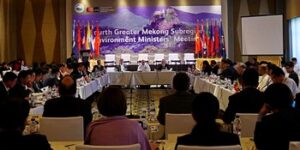
H.E. U Win Tun, Union Minister for Environmental Conservation and Forestry, Myanmar, delivers the welcoming address. Photos by R. Daniel.
The ADB held its fourth Environment Ministers Meeting in Nay Pyi Taw, Myanmar, on 27–29 January, with the theme of “Increasing Investments in Natural Capital in the Greater Mekong Subregion”. SEI Asia Centre Director Eric Kemp-Benedict, Research Fellow Albert Salamanca and Communications Coordinator Rajesh Daniel participated in the event.
The ADB hosts a Greater Mekong Subregion Environment Ministers’ Meeting (EMM) every three years to review environmental challenges and regional responses. This time the focus was on “scaling up efforts to protect and enhance natural capital to achieve inclusive and sustainable development in the GMS”.
“The key challenge to securing natural capital investments has been to gain adequate recognition that natural capital assets generate economically valuable goods and services,” said H.E. U Win Tun, Union Minister for Environmental Conservation and Forestry, Myanmar, in his welcoming address.
“Though nature’s services have long been considered as ‘free’ or ‘public’ goods, there is growing recognition globally both within the public and private sectors that ecosystem services do generate economically valuable goods and services,” he added.
Kemp-Benedict noted that the EMM is an important venue for environment ministers in the Mekong Region and its regional and international development partners to discuss critical environmental concerns and highlight emerging priorities in the region. And indeed, the event was well attended, drawing about 400 participants from Mekong governments, the private sector, civil society and the Myanmar media.

The Myanmar delegation
Yet except for host Myanmar, none of the Mekong Region countries actually sent its environment minister. Questions also persisted about the practical usefulness of the concept of “natural capital” – particularly as the EMM4 followed the fifth GMS Summit, held in December 2014.
At the Summit, country leaders endorsed the US$30 billion Regional Investment Framework (RIF) Implementation Plan (2014–2018) backed by the ADB; 90% or US$27 billion is to be spent on inland and transboundary road networks.
Can the RIF be reconciled with protection of natural capital? The Joint Ministerial Statement at the end of the conference said: “Natural capital/resources lie at the heart of economic development. Future prosperity of the GMS will depend on timely and effective investments to protect and enhance its natural capital/resources.”
Understanding natural capital at EMM4
Dr. Daw Thet Thet Zin, Deputy Minister of Environmental Conservation and Forestry, defined natural capital as “the stock of capital driven from natural resources such as biodiversity and ecosystems, in addition to geological resources such as fossil fuels and mineral deposits”.
“It also underpins a range of ecosystem services which are central to the livelihoods of people,” he added, “particularly to economically marginalized or resource-dependent people, as their subsistence livelihoods highly rely on ecosystem services and functions that underpin our economy and indirect benefits to business.”
But how is this concept different from previous attempts at natural resource management?
Ancha Srinivasan, climate specialist with the ADB, said that the natural capital concept is an attempt to go beyond resource management: “The new demands on the environment are so huge that we need to bring in new resources, and additional investments from the private sector. The challenge for EMM is how to coordinate with other ministries such as energy, finance and planning while undertaking the US$30 billion worth of investments.”
But at least some of the policy-makers seemed uncertain of the concept’s practical usefulness.
Xaypladeth Choulamany, Director-General of Planning and Cooperation for the Ministry of Agriculture and Forestry in Lao PDR, said natural capital “seems to be the new buzzword” – yet it might help policy-makers better understand environmental externalities.
“We still need more understanding of the term [natural capital], and more awareness about what it means for policy,” Choulamany said. “We are already taking environmental considerations into account in policy and planning in Laos. But it seems this concept is more for the private sector’s benefit, to make them conscious of corporate social responsibility.”
Dr. Wijarn Simachaya, Permanent Secretary of Thailand’s Ministry of Environment and Natural Resources, said natural capital “is a good concept, but the important things is how to increase public awareness of natural resources conservation”.
“When we say ‘capital’, people may think of money and investment,” he added. “So we need to know how to interpret the technical term in public in general and for implementation in the Mekong Region.”
Kemp-Benedict said the attention to environmental concerns at EMM4 was still a good sign.
“Although the RIF is well advanced, and there is some concern that attempts to modify it are too little and arrive too late, the focus on natural capital in the recent meeting is a welcome step,” he said. “Despite public statements in support of green and sustainable development from the Mekong Region countries, the value of natural capital is rarely considered in regional development plans, and the support of national ministries was a satisfying outcome.”
Myanmar’s development priorities
One of Asia’s poorest countries, Myanmar is just emerging from decades of economic isolation and armed conflict. Its vast natural resources are being exploited for economic gain, from timber and jade to gold, coal and hydropower. Foreign direct investment rose from US$1.9 billion in fiscal year 2011–12 to $2.7 billion in 2012–13, more than 40% by China.

Pavan Sukhdev
Yet Myanmar remains desperately in need of schools, hospitals, public transport, and modernization of its agriculture systems. Its government staff are some of the worst-paid in the world. Does it make sense for the ADB to prioritize road-building in Myanmar?
The environmental economist Pavan Sukhdev questioned the social and environmental sustainability of the RIF in his presentation, asking if these roads were merely a subsidy for private transportation:
“Is the plan to get people more cars and the ADB builds more roads or are we helping with public transportation?” he asked. “Are these roads clearing forests, or are they able to avoid biodiversity areas?”
See presentations and other materials from EMM4 (external link)
Design and development by Soapbox.


